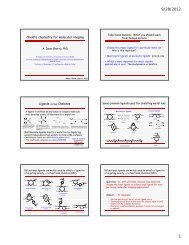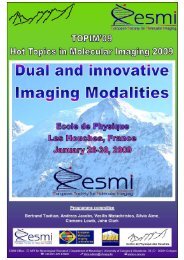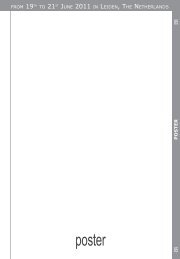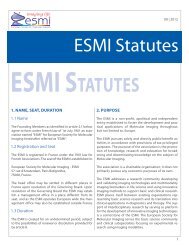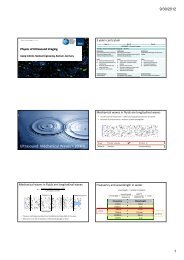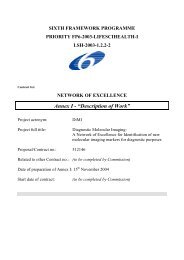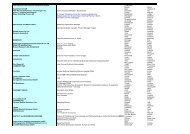5th EuropEan MolEcular IMagIng MEEtIng - ESMI
5th EuropEan MolEcular IMagIng MEEtIng - ESMI
5th EuropEan MolEcular IMagIng MEEtIng - ESMI
You also want an ePaper? Increase the reach of your titles
YUMPU automatically turns print PDFs into web optimized ePapers that Google loves.
88<br />
WarSaW, poland May 26 – 29, 2010<br />
Evaluation of the temporal window for drug delivery following ultrasound mediated<br />
membrane permeability enhancement<br />
Yudina A. (1) , Lepetit-Coiffé M. (1) , Moonen C. (1) .<br />
Laboratoire IMF CNRS UMR 5231 / Université Bordeaux 2, France<br />
anna@imf.u-bordeaux2.fr<br />
Introduction: Ultrasound (US)-mediated delivery<br />
is a new therapeutic option to locally facilitate the<br />
passage of drugs through cell plasma membrane<br />
by reversibly altering its permeability[1] possibly<br />
via the formation of pores that are known to spontaneously<br />
reseal within a short time – seconds to<br />
minutes[2]. However under certain conditions the<br />
effects of US for drug delivery last for hours after<br />
the exposure[3]. The present work is the first in<br />
vitro attempt to confirm and quantitatively assess<br />
the temporal window for the US-mediated intracellular<br />
drug delivery by live-cell imaging.<br />
Methods: Cell-impermeable optical chromophores<br />
with fluorescence intensity increasing 100-1000<br />
fold upon intercalation with nucleic acids served<br />
as smart agents for reporting cellular uptake. Opticell<br />
chambers with a monolayer of C6 cells were<br />
subjected to ultrasound in the presence of microbubbles<br />
followed by varying delays between<br />
0 and 24 hours before addition of Sytox Green<br />
optical contrast agent. Micro- and macroscopic<br />
fluorescence imaging was used for qualitative and<br />
quantitative analysis.<br />
Results: Strong enhancement of the fluorescence<br />
signal upon binding to nucleic acids allowed efficient<br />
visualization of the local effect of US on internalization<br />
of cell-impermeable intercalating dyes.<br />
Up to 25% of viable cells showed uptake of contrast<br />
agent with a half time of 8 hours, with cellular uptake<br />
persisting even at 24 hours (Figure 1). Only<br />
cells exposed to ultrasound showed the effect.<br />
imaging life<br />
Conclusions: Optical imaging showed that temporal<br />
window of increased membrane permeability is<br />
much longer than previously suggested. This may<br />
have important repercussions for in vivo studies in<br />
which membrane permeability may be temporally<br />
separated from drug administration to better adapt<br />
to pharmacokinetic / pharmacodynamic properties<br />
of the drug or drug carrier.<br />
Acknowledgement: This work is supported by the<br />
EC-project FP7-ICT-2007-1-213706 SonoDrugs and<br />
Foundation InNaBioSanté-project ULTRAFITT. Microscopy<br />
was performed in the Bordeaux Imaging<br />
Center of the Neurosciences Institute of the University<br />
of Bordeaux II.<br />
References:<br />
Figure 1. In the absence of US<br />
only occasional cells with the<br />
compromised membrane show<br />
the uptake of cell-impermeable<br />
Sytox green (A). However the<br />
effects of the US on membrane<br />
permeability can last up to<br />
24h (B), with the fluorescence<br />
intensity increasing as the time<br />
between US application and<br />
fluorophore administration<br />
shortens (C-F).<br />
1. Hernot S, Klibanov AL; Adv Drug Deliv Rev. 60(10):1153-<br />
66 (2008)<br />
2. van Wamel A et al.; J Control Release. 112(2):149-55<br />
(2006)<br />
3. Hancock HA et al. Ultrasound Med Biol. 35(10):1722-36<br />
(2009)



